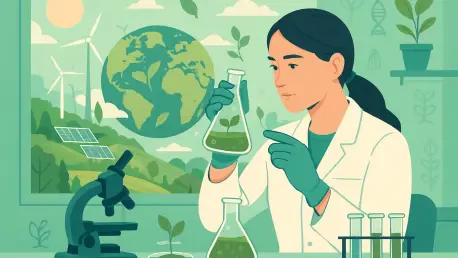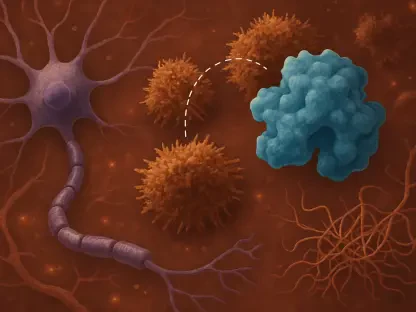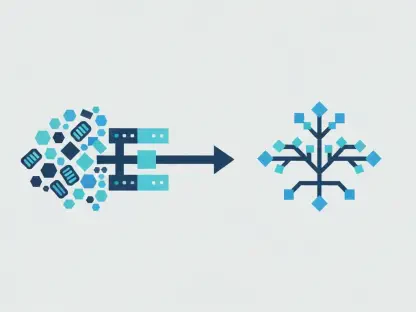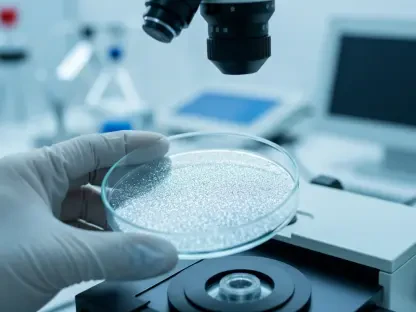Imagine a world where scientific innovation doesn’t just address human ailments but also heals the environmental wounds inflicted over centuries of industrialization. Bioengineering, an interdisciplinary field blending biology, chemistry, and engineering, emerges as a powerful force in this transformative vision, offering groundbreaking solutions to critical global challenges like climate change, pollution, resource depletion, and biodiversity decline. This isn’t a distant dream but a reality taking shape through tangible advancements that are already reshaping how humanity interacts with the planet. From cleaner energy sources to restored ecosystems, the scope of bioengineering’s impact is vast and inspiring, promising a future where sustainability and health go hand in hand. Yet, as this field pushes boundaries, it also prompts vital questions about ethical limits and unintended consequences. Striking a balance between bold innovation and cautious responsibility remains a central theme in harnessing bioengineering’s full potential for the greater good.
Applications in Energy and Waste Management
Clean Energy Breakthroughs
Bioengineering is redefining the energy landscape by introducing sustainable alternatives that challenge the dominance of fossil fuels. Through the genetic modification of organisms such as algae and specific crops like switchgrass, scientists have developed biofuels that significantly lower greenhouse gas emissions compared to traditional oil-based fuels. These biofuels also reduce the need for deforestation linked to oil exploration, preserving vital habitats. Additionally, biogas production, driven by engineered bacteria, converts agricultural and food waste into usable methane or hydrogen for power and heating. This dual benefit addresses waste management while providing renewable energy, reducing the environmental footprint of energy grids. The adoption of such technologies signals a shift toward cleaner air and a more resilient energy infrastructure, demonstrating bioengineering’s capacity to tackle interconnected environmental issues with precision and efficiency.
Beyond the immediate environmental gains, the scalability of bioengineered energy solutions offers hope for widespread global impact. Projects utilizing biogas from waste are already powering communities in various regions, cutting down on methane emissions that would otherwise escape from decomposing materials in landfills. Meanwhile, algae-based biofuels are being refined to maximize carbon dioxide absorption during production, turning a greenhouse gas into a resource for clean fuel. These initiatives not only curb pollution but also reduce dependency on finite resources, fostering energy independence for many nations. The momentum behind these developments suggests a future where bioengineering could play a pivotal role in meeting global energy demands sustainably, provided that investment and policy support continue to align with scientific progress. This forward-looking approach underscores the field’s potential to reshape energy consumption patterns for the better.
Tackling Pollution with Microbes
In the fight against pollution, bioengineering presents a revolutionary approach through the use of specially designed microbes to address pervasive waste issues. Engineered bacteria capable of producing enzymes that break down synthetic plastics into reusable materials are at the forefront of combating the global plastic crisis. These microbes target items like bottles and polyester fabrics, reducing landfill accumulation and halting the spread of microplastics that threaten wildlife and infiltrate food chains. Field tests have shown promising results, with significant reductions in plastic waste at trial sites, hinting at a future where waste could be transformed into valuable resources. This innovation offers a glimpse of a cleaner environment where pollution is no longer an insurmountable burden but a manageable challenge.
Moreover, bioengineering extends its reach to tackle toxic contaminants such as oil spills, pesticides, and heavy metals that plague soil and water systems. Microbes tailored to consume these pollutants provide an eco-friendly alternative to conventional chemical cleanup methods, which often leave harmful residues or incur high costs. Successful applications in contaminated areas have demonstrated dramatic improvements in environmental quality, with reduced toxin levels restoring ecosystems to safer conditions. Unlike traditional approaches, these biological solutions minimize secondary damage, preserving natural balances while addressing human-induced harm. As research advances, the potential for scaling these microbial interventions could redefine pollution management, ensuring healthier landscapes and waterways for future generations through sustainable and cost-effective means.
Advancements in Agriculture and Food Security
Sustainable Crop Innovations
Bioengineering is revolutionizing agriculture by developing crops engineered to thrive under increasingly challenging conditions brought on by climate shifts. Genetically modified varieties, such as drought-tolerant maize and pest-resistant cotton, are designed to endure harsh weather and resist infestations without heavy reliance on water, fertilizers, or pesticides. These advancements protect vital resources by reducing runoff into rivers and streams, which often carries harmful chemicals that damage aquatic ecosystems. Farmers in vulnerable regions have reported more consistent yields despite unpredictable rainfall, showcasing how such innovations directly support livelihoods while safeguarding environmental health. This targeted approach to crop improvement highlights bioengineering’s role in creating a more sustainable agricultural framework that benefits both people and the planet.
The ripple effects of these bioengineered crops extend beyond individual farms to influence broader ecological systems. By minimizing the need for chemical inputs, these plants help preserve soil integrity, preventing erosion and degradation that can render land unusable over time. Water conservation, a critical issue in many arid regions, is also bolstered as crops require less irrigation to flourish. This reduction in resource use not only lowers costs for farmers but also mitigates the strain on local water supplies, ensuring availability for other needs. As global populations continue to grow, the ability of bioengineering to enhance agricultural resilience offers a promising path to maintaining food supplies without sacrificing environmental stability, paving the way for farming practices that align with long-term planetary health goals.
Ensuring Long-Term Viability
The long-term benefits of bioengineered crops lie in their capacity to sustain agricultural productivity amidst evolving environmental pressures. By focusing on traits like nutrient efficiency, these crops reduce the dependency on synthetic fertilizers, which often contribute to greenhouse gas emissions and soil nutrient depletion. This shift helps maintain fertile land for future planting cycles, addressing concerns about diminishing arable resources. Additionally, the stability provided by resilient crops supports rural economies, particularly in regions prone to climate-related disruptions, ensuring that food production remains a reliable pillar of community well-being. Bioengineering’s contribution here lies in its foresight, crafting solutions that anticipate and adapt to challenges over decades.
Furthermore, the global implications of these agricultural advancements cannot be overstated, especially in the context of food security. Stabilizing yields in areas hit hardest by changing weather patterns means fewer hunger crises and less strain on international aid systems. Bioengineered crops also play a role in reducing food waste by extending shelf life through enhanced resistance to spoilage, ensuring more produce reaches consumers. This efficiency is vital as demand for food rises, requiring systems that can produce more with less environmental impact. Through careful integration of genetic tools, bioengineering fosters a model of agriculture that not only meets current needs but also secures a foundation for future generations, balancing productivity with ecological stewardship in a way that traditional methods often struggle to achieve.
Conservation and Ecosystem Restoration
Protecting Biodiversity
Bioengineering serves as a critical ally in conservation, employing genetic techniques to safeguard biodiversity against mounting threats. Through methods like genetic rescue, endangered species such as black-footed ferrets gain resistance to deadly diseases, bolstering their chances of survival in the wild. Similarly, gene editing is used to control invasive species, like mosquitoes that spread malaria, by altering breeding patterns to reduce populations without resorting to harmful chemicals. These precise interventions prevent ecosystem imbalances that occur when invasive species outcompete native ones, preserving the delicate web of life. Such efforts underscore bioengineering’s potential to address specific conservation challenges with tailored solutions that enhance natural resilience.
In addition to species-specific interventions, bioengineering contributes to broader biodiversity goals by strengthening genetic diversity within populations at risk. Low diversity often leaves species vulnerable to environmental changes or diseases, but targeted genetic enhancements can introduce vital adaptability. For instance, coral species engineered with heat-resistant traits are better equipped to withstand rising ocean temperatures, protecting marine ecosystems that support countless other organisms. These advancements help maintain the intricate relationships within food webs, ensuring that the loss of one species doesn’t cascade into wider collapse. By fortifying biodiversity at its genetic core, bioengineering offers a proactive strategy to combat extinction rates, reinforcing the foundation of healthy, dynamic ecosystems across diverse habitats.
Restoring Habitats
Habitat restoration, a cornerstone of environmental recovery, is significantly advanced through bioengineering’s innovative approaches. Native plants, modified to exhibit greater resilience against harsh conditions, are reintroduced into degraded areas to provide essential food and shelter for wildlife. This process aids in rebuilding ecosystems that have been eroded by human activity or natural disasters, fostering environments where species can thrive once more. Projects focusing on coral reef restoration, for example, utilize genetically enhanced corals to endure warmer waters, reviving underwater habitats that serve as nurseries for marine life. Such initiatives illustrate how bioengineering can breathe new life into landscapes, ensuring they support biodiversity and ecological balance.
Equally important is the role of restored habitats in enhancing ecosystem services that benefit both nature and human communities. Revitalized areas contribute to cleaner water systems by filtering pollutants through natural processes, while also stabilizing soil to prevent erosion during extreme weather. These restored zones act as buffers against climate impacts, absorbing carbon and mitigating flood risks in surrounding regions. Bioengineering’s precision in tailoring plants and organisms for specific restoration needs ensures that efforts are not only effective but also sustainable over time. By rebuilding these natural systems, the field helps create a network of resilient habitats that can withstand future challenges, securing a healthier planet where ecosystems and human well-being are deeply intertwined.
Ethical and Practical Challenges
Navigating Risks
While bioengineering holds immense promise, it also carries significant risks that demand careful consideration and robust safeguards. The potential for unintended ecological consequences, such as disrupting food chains or harming non-target species, looms large when introducing genetically modified organisms into natural environments. Rigorous testing protocols and long-term monitoring are essential to detect and mitigate any adverse effects before they escalate. Historical lessons from other technological interventions remind us that even well-intentioned innovations can have ripple effects, making it imperative to approach bioengineering with a precautionary mindset. Ensuring that these powerful tools do not compromise the very systems they aim to protect remains a top priority for researchers and policymakers alike.
Beyond ecological concerns, the complexity of predicting long-term outcomes in dynamic ecosystems adds another layer of challenge to bioengineering applications. Even with advanced modeling, the interactions between engineered organisms and their surroundings can yield unexpected results, potentially altering habitats in unforeseen ways. This uncertainty necessitates international collaboration to establish standardized guidelines for testing and deployment, ensuring consistency in safety measures across borders. Public transparency about risks and ongoing research findings also plays a crucial role in maintaining trust, as communities need assurance that potential downsides are being actively addressed. Navigating these uncertainties with diligence and foresight is vital to harnessing bioengineering’s benefits without jeopardizing environmental integrity.
Balancing Innovation and Responsibility
The ethical dimensions of bioengineering require a delicate balance between pushing scientific boundaries and adhering to societal values. Public perception often varies widely, with concerns about “playing God” or creating unnatural systems influencing acceptance of these technologies. Engaging communities through education and dialogue is essential to address fears and highlight the tangible benefits, such as cleaner energy or enhanced food security. Ethical frameworks must guide the development and application of bioengineering to ensure that interventions align with cultural and moral expectations, preventing backlash that could stall progress. This alignment fosters a sense of shared responsibility, ensuring that advancements serve the collective good rather than narrow interests.
Moreover, responsible stewardship in bioengineering extends to equitable access and distribution of its benefits, particularly in underserved regions. Ensuring that innovations like drought-resistant crops or pollution-cleaning microbes reach those who need them most requires intentional policy and investment, avoiding scenarios where only wealthier nations reap the rewards. International cooperation can help address disparities, while strict oversight prevents misuse or commercialization that prioritizes profit over planetary health. Striking this balance between innovation and accountability is not just a technical challenge but a societal one, demanding that bioengineering evolves in a way that respects both human dignity and environmental limits. Only through such careful management can the field fulfill its promise of a sustainable future.
Looking Ahead: Shaping a Resilient Future
Reflecting on the strides made, bioengineering has carved out a remarkable path in addressing some of the planet’s most daunting environmental hurdles. Its contributions to cleaner energy through biofuels, pollution reduction via engineered microbes, sustainable agriculture with resilient crops, and conservation through genetic tools have already shown measurable impacts in diverse global contexts. These achievements underscore a pivotal shift toward integrating biological ingenuity with technological precision, proving that humanity can mend its relationship with nature through thoughtful innovation.
Looking to the next steps, the focus must pivot to scaling these solutions while embedding stronger ethical and safety frameworks. Collaborative efforts among scientists, policymakers, and communities should prioritize accessible implementation, ensuring that bioengineering’s benefits reach every corner of the globe. Investment in research to anticipate and address potential risks will be crucial, as will transparent communication to build public trust. By fostering a culture of responsibility alongside innovation, bioengineering can continue to evolve as a cornerstone of a healthier, more sustainable planet, guiding humanity toward resilience in the face of ongoing and emerging challenges.









